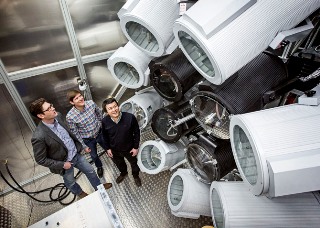Feb 26 2015
Stockholm is one of the world's most sunlight-deprived capitals for almost half of the year. But now, the city's premier technical university, KTH Royal Institute of Technology, is home to one of the world's few solar laboratories.
 KTH's Solar Lab is one of only seven such research facilities in the world. (Photo: Håkan Lindgren)
KTH's Solar Lab is one of only seven such research facilities in the world. (Photo: Håkan Lindgren)
Concentrated solar power can be part of the solution for sustainable energy in the future — not least in those developing countries where sunshine is plentiful.
On February 27, one of the few solar laboratories in the world is will be officially opened at Sweden's KTH Royal Institute of Technology.
"Because there are so few facilities of this type in the world, we started by building one," says Björn Laumert, associate professor at the Department of Energy Technology at the School of Industrial Engineering and Management.
In three years, he along with a number of graduate students and echnicians built up the KTH Solar Lab, with a solar simulator to enhance knowledge and research on, among other things, concentrated solar power, or thermal solar power.
"Solar cells have been applied commercially since the 1970s, while concentrated solar power started becoming news in the 1990s," Laumert says.
He suggests, however, that for centuries people have known the principle of concentrating solar power in a very small area using mirrors or dishes that create high levels of heat and thus can generate energy.
Legend has it that in the siege of Syracuse, between 212 and 214 BCE, Archimedes concentrated solar energy through mirrors directed against enemy ships. The sails were burned up, and the supposedly ships sank.
The heat and radiation in today's concentrated solar power is much more potent, as a visitor can easily see.
The inside of the laboratory resembles a square tin. All surfaces are covered with metal that can handle the power, radiation and heat, which can easily climb to 2,000 C degrees. Rigorous ventilation is a must. The plant is controlled from a control panel outside the laboratory. Apart from computer screens, you can follow the experiments with the naked eye through small peepholes of reinforced glass on one side.
Twelve extremely powerful spotlights simulate the sun at 7 kilowatts each, generating and shining light on a small area of 20 square cm. By using different types of lenses, loupes, and filters they can experiment with and concentrate solar energy in different ways, which creates a light output of up to 6.7 megawatts per square meter.
Experiments are controlled from outside of the solar simulation chamber.
"The solar energy in here is 6,000 times stronger than the way we experience the sun on the earth, Laumert says.
The light is converted to heat in a receiver that drives a gas or steam turbine alternatively, via a Stirling engine, which in turn generates electricity or heat.
Unlike solar cells that convert light into electricity directly, the concentrated solar energy can be stored as heat and used even when the sun does not shine. Storage, cost, and conversion are the central challenges in order to use solar power as a sustainable resource.
Solar power is free and available energy that creates no greenhouse gases. To live up to the EU's climate goals and create a sustainable society, it one of several indispensable renewable energy sources," he says.
What works best is, of course, dependent on each country's conditions. Solar power works best where the flow of sunlight is even and strong, such as in desert areas like the Sahara.
"Industrialization and energy are interrelated. You could say that the industrialized countries exhausted their right in terms of energy consumption and emissions to build their wealth," Laumert says.
"Should developing countries industrialize correspondingly, it requires much more energy than you can get from coal and oil, since those are destructive and not sustainable. Many developing countries have plenty of sunlight so it may be a way forward."
More ways to store energy and lower the cost of generation will be key to competing in a commercial market, he says.
KTH's Solar Lab will primarily be used for research into solar power and solar receivers. However, the laboratory will also be used for basic research on one hand, high temperature material, as used in the construction of rocket engines or fusion reactors, and also to investigate chemical reactions under high light output.
Even though Sweden is not bathed in sun and light, especially in winter, there is a strong industrial interest in developing both parts of the technology as a whole, both here and in Europe.
Today there are a number of research projects in collaboration with Siemens in Sweden, Cleanergy and the Swedish Energy Agency around the development of photovoltaics and solar power plants. For example, under examination is how photovoltaics can be made more effective and how solar energy interacts with other fuels.
Outside the laboratory stand doctoral student Luke Aichmayer and Wujun Wang. They have, like Jorge Garrido and departmental technicians, helped build the lab.
"It has been very exciting to develop the entire design. Every little detail is important," Aichmayer says.
His thoughts are echoed by Wang, who eventually sees the opportunity to develop many small-scale solar power plants in rural areas of China to replace dirty diesel generators.
"I think this has the potential to become a success story," he says.
Source: http://www.kth.se